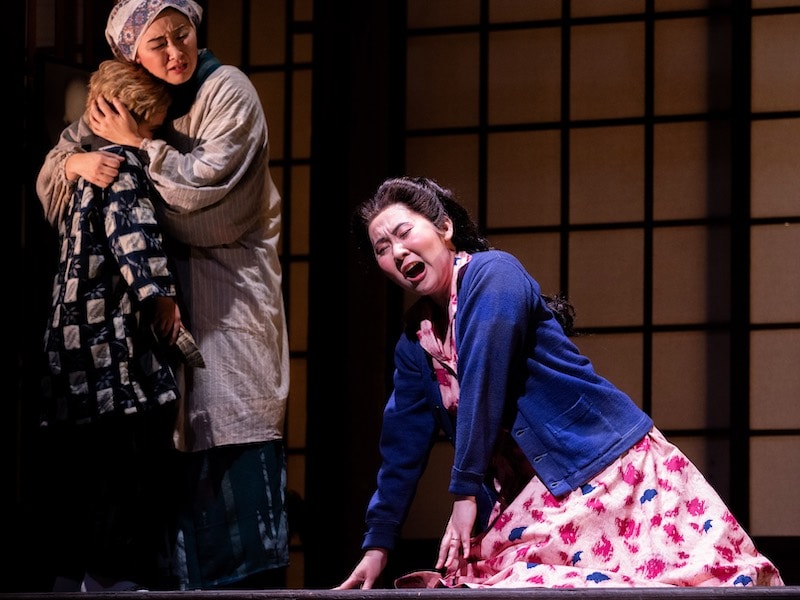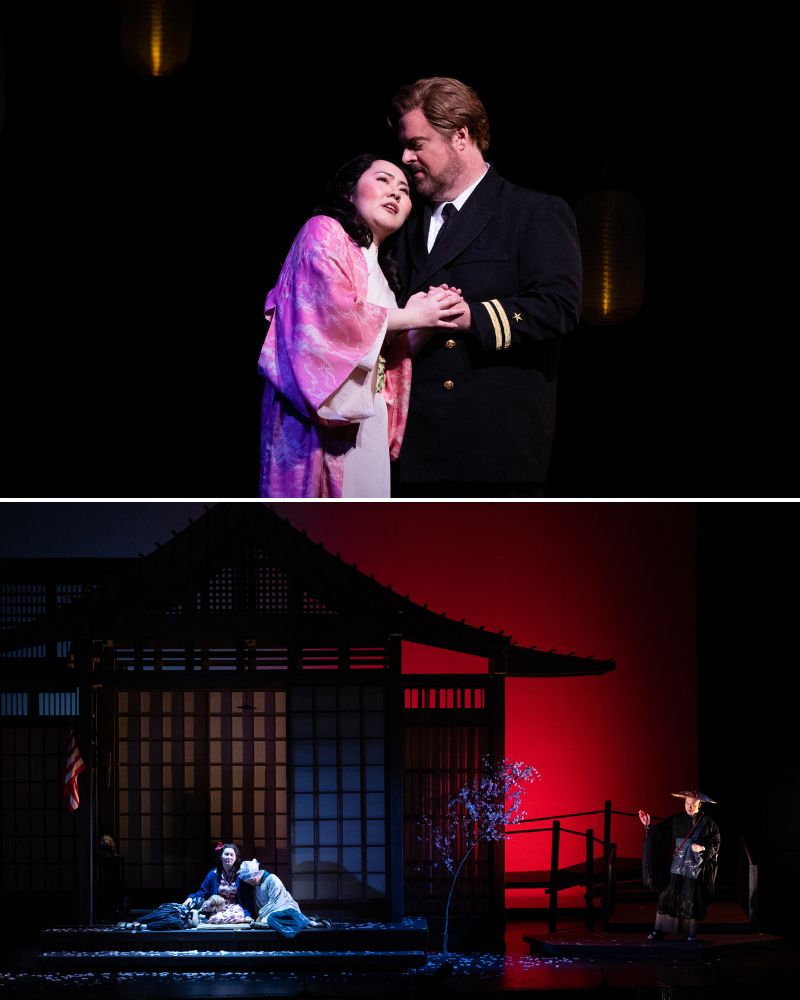Therapists tell us that therapy teaches one how to feel. Many people don’t like facing strong emotions. Virginia Opera’s Madama Butterfly at George Mason University was an emotional opera that featured powerhouse performances. With themes of abandonment and cultural conflicts, Madama Butterfly makes the audience feel deeply.
Set in post-WWII Nagasaki, Japan, in 1946, this opera follows the tragic story of Cio-Cio-San, a young Japanese geisha who falls in love with American Navy Lieutenant Pinkerton. Pinkerton leaves for America without a pregnant Cio-Cio-San. Cio-Cio-San’s hopes are challenged when Pinkerton returns to Japan and wants to wed an American woman and return Cio-Cio-San’s child to the United States.

Much has been written about the origins of the story and the troubling marital and racial themes in this work. It’s been estimated that at least 45,000 Japanese women married American soldiers after WWII. Many of them were seen as traitors to their race and religion. The producers published a list of resources about the show here.
The score was written by the classical composer Giacomo Puccini (1858–1924). The original opera premiered on February 17, 1904, and was a flop. Virginia Opera Resident Scholar Josh Borths spoke at length about the history of the opera here.
The cast’s vocals, sung in Italian, were strong and expressive, bringing the audience into the heartbreaking story. From Cio-Cio-San’s delicate soprano to Pinkerton’s impassioned tenor, each vocalist brought their role to life onstage. A drawback, however, was the English subtitles that were broadcast above the stage, which made for much head bobbing as I watched the players and the lyrics.
Karen Chia-ling Ho was a tour-de-force as Cio-Cio-San. She literally sang Pinkerton’s praises. Her angelic voice was most haunting in the scenes in which she waited for Pinkerton to return. This was her Virginia Opera debut.
Jonathan Burton played Benjamin Franklin Pinkerton with vigor and the lack of empathy you’d expect for his character. Pinkerton spoke of his desire to get married to a “good American woman.” That character seemingly didn’t take marriage to a Japanese woman — or Japanese law — seriously. I was put off by Burton’s dismissal of his villain role and the jeers he got at the curtain call. (Similar to Shakespeare’s character and real-life English King Richard III, not everyone agrees Pinkerton is a villain.)

Kristen Choi was an audience pleaser as Cio-Cio-San’s maid Suzuki. Choi had great chemistry with Ho. Her alto voice was supreme. Opera News called her a “powerhouse in the making.”
Cio-Cio-San had a rival suitor to Pinkerton: Prince Yamadori. Despite his pleas for her to come and live in luxury with him, she “stood by her man.” Yamadori was well played by Yinghui He.
Grant Youngblood played the American Consul Sharpless. He is a baritone with a commanding presence, who has been in a multitude of operas.
Alana Kypros played Cio-Cio-San’s son, Sorrow. Kypros did much acting with subtle body language. Zizhao Wang turned in a good performance as the Imperial Commissioner.
The music in Madama Butterfly was somber. The orchestration beautifully conveyed the characters’ emotions. Conductor Adam Turner was flawless here.
Stage Director Mo Zhou and Assistant Director Adam Da Ros made all the elements of this complex show work well together. Zhou will direct the world premiere of The Big Swim at the Houston Grand Opera this season.
The stage design for Madama Butterfly was impressive. It consisted of a center-stage Japanese-style home with sliding doors and latticework walls. There was a charming, wooden footbridge house right. Above this, Scenic Designer Wallace Coberg, placed a cherry blossom branch, from which blossoms rained when appropriate. I liked the American President portrait props that got changed by Cio-Cio-San as the years went by.
Costume Designer Ruoxuan Li earned her paycheck. The cute kimonos and dapper suits evoked the period. Complementing the costumes were Wig and Make-up Designer Elyse Messick’s impressive wigs that she put on the actors portraying Japanese women (some of whom were white and African American). I liked the changes in colors projected on the upstage scrim by Lighting Designer Marie Yokoyama.
Madama Butterfly’s tear-jerking plot, music, and heartfelt singing combined to produce a powerful evening of opera. It’s an emotional journey that will have you thinking about its themes after it’s over.
Running Time: Approximately two hours and 45 minutes, including a 15-minute intermission.
Madama Butterfly played March 16 and 17, 2024, presented by Virginia Opera performing at George Mason Center for the Arts at George Mason University, 4373 Mason Pond Drive, Fairfax, VA. For tickets to future George Mason Center for the Arts shows, find them online.
The Madama Butterfly program is online here.
Madama Butterfly
Music by Giacomo Puccini
CAST
Cio-Cio-San played by: Karen Chia-ling Ho
Lt. Pinkerton played by: Jonathan Burton
Suzuki played by: Kristen Choi
Sharpless played by: Grant Youngblood
Goro played by: Zhengyi Bai
The Bonze played by: Taewon Sohn
Prince Yamadori played by: Yinghui He
The Imperial Commissioner played by: Zizhao Wang
Kate Pinkerton played by: Katherine Sanford Schrock
The Official Registrar played by: Erik Grendahl
Sorrow played by: Alana Kypros
ARTISTIC AND CREATIVE TEAM
Conductor: Adam Turner
Stage Director: Mo Zhou
Costumes Designer: Ruoxuan Li
Lighting Designer: Marie Yokoyama
Wig & Make-up Designer: Elyse Messick
Movement & Cultural Consultant: Asuka Morinaga Derfler
Assistant Director: Adam Da Ros





Titles projected above the stage are called supertitles. I’ve never seen subtitles projected below a stage. Have you? Sorry that was off putting for you. The Met has the translation digitally displayed on the back of the seat in front of you. I think I’d rather keep looking up, than down.
This is so interesting! I’m going to the Met in May for the first time, and I’m very excited — I primarily watch opera locally or online, so I have not seen translations on the seat in front of me before. How innovative! I find supertitles difficult, but I’m not sure if this is much better. We’ll see…regardless, a lot of head bobbing.
Dear Mr Powell,
Thank you for attending our show and offering your thoughts on it. I wasn’t able to understand your meaning here: “I was put off by Burton’s dismissal of his villain role and the jeers he got at the curtain call”. I’d love to understand what I did to put you off so I can avoid it in the future. Thank you kindly.
That first photo is filled with so much emotion – I’m sorry I missed this one! William, you described this performance beautifully and I regret not seeing it. I am curious about the jeers Pinkerton got at curtain call…was he booed? Or was it maybe jeers for portraying a villain well? Illuminating review.
@KJ Moran Velz: Thank you for your comment. The atmosphere at the curtain call was emotionally charged. While some jeers were directed towards Pinkerton’s character, much of the feedback was a testament to Burton’s skill in portraying a complex role. I hope you get to see this show one day.
@Ron Milovac: Thank you for sharing your thoughts and reading my review. You are right, supertitles aka surtitles, are projected above the stage in many theaters. While some prefer looking up, others, like me, may find the digital display on the back of the seats more convenient. It’s all about personal preference. Cheers.
@Johnathan Burton:
Thank you for your commitment to seeking feedback and for your dedication to your craft. Portraying a villainous character is tricky and there are many nuances to navigate. I salute you for your courage in embracing the challenge of portraying such a multi-dimensional character. The fact that you received some jeers indicated that you did your job well. Those reactions indicate a deep connection and emotional investment in the character.
Though it was not your intent, I think you came off as somewhat dismissive of what Pinkerton did. Your body language and hand gestures showed defensiveness. You seem to have had a “who me?” attitude. Defensiveness can cause escalation.
If I was directing the curtain call, I would have had you break character immediately and nod in agreement at the jeers you received, as if to say, “yeah he was a bad guy wasn’t he?” It could be that the “who me?” attitude was an attempted break from the character, but the audience was coming off the emotions of seeing Cio-Cio-San kill herself over the dilemma Pinkerton put her in. Performers are aware it’s make-believe, audiences not as much.
Perhaps you could have used your body language and facial expressions to convey a sense of detachment from Pinkerton. Another option would be to grimace and ignore the jeers. You could have directed your attention to your fellow cast members, emphasizing the show is a collective effort rather than about Pinkerton.
I don’t know if I’m versed enough to give you the best answer, as I’ve never played a villain onstage. It could be there’s no good answer—damned if you do, damned if you don’t. I urge you to seek counsel from people more experienced than me, as this is a sticky wicket. I urge you to practice self-care when taking on such disturbing characters, and I wish you much success in your future shows!